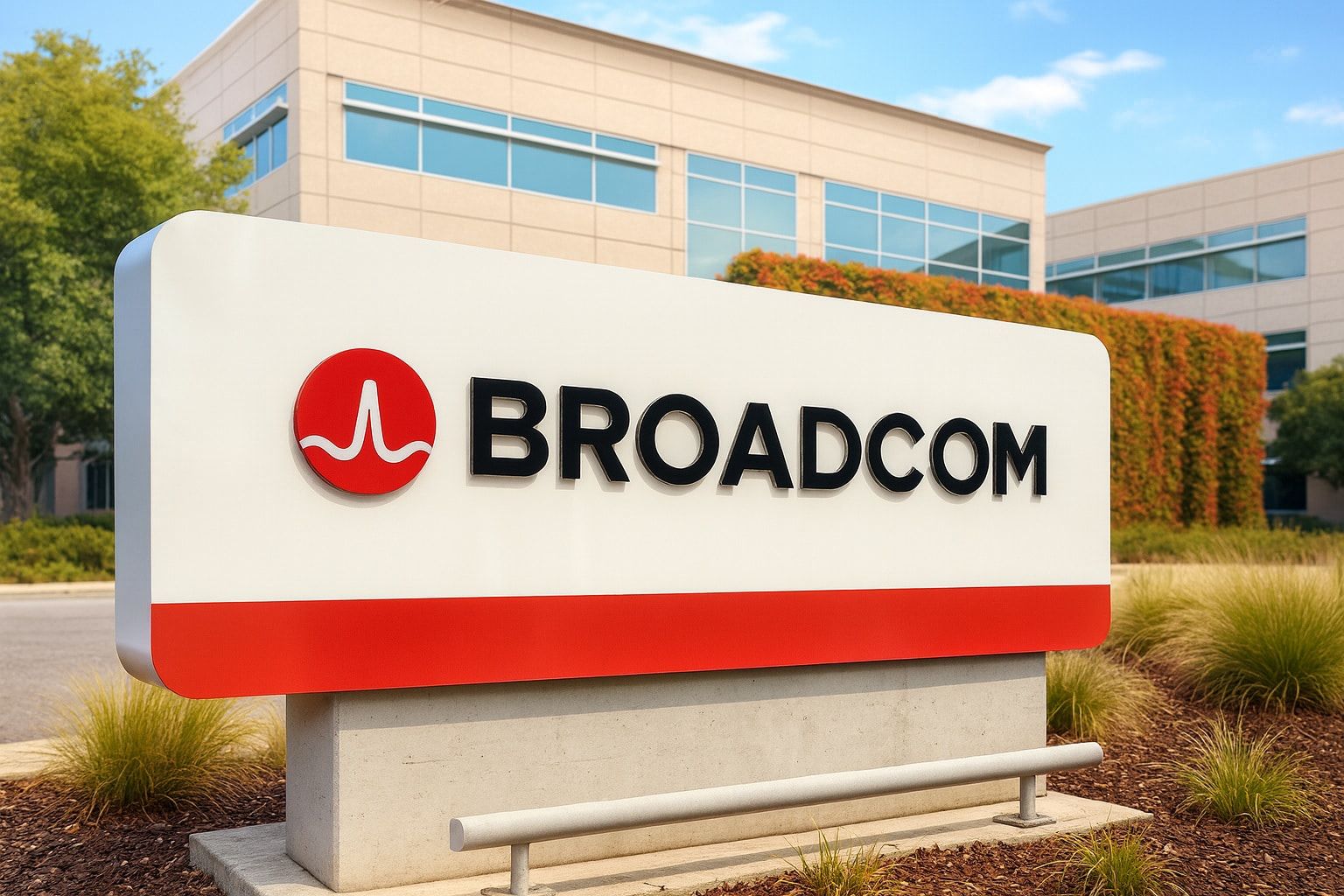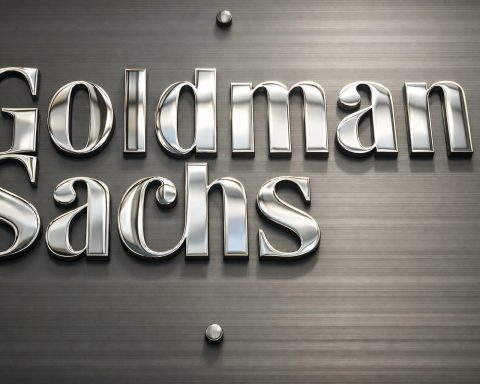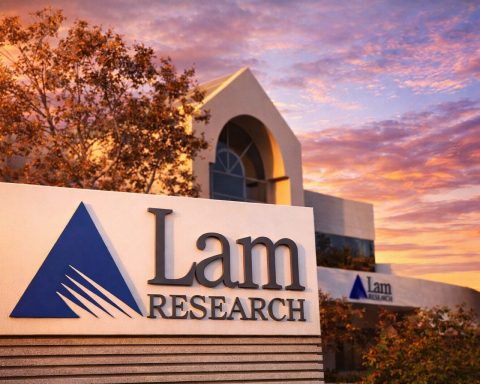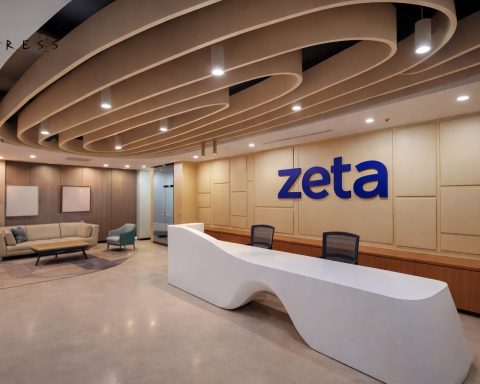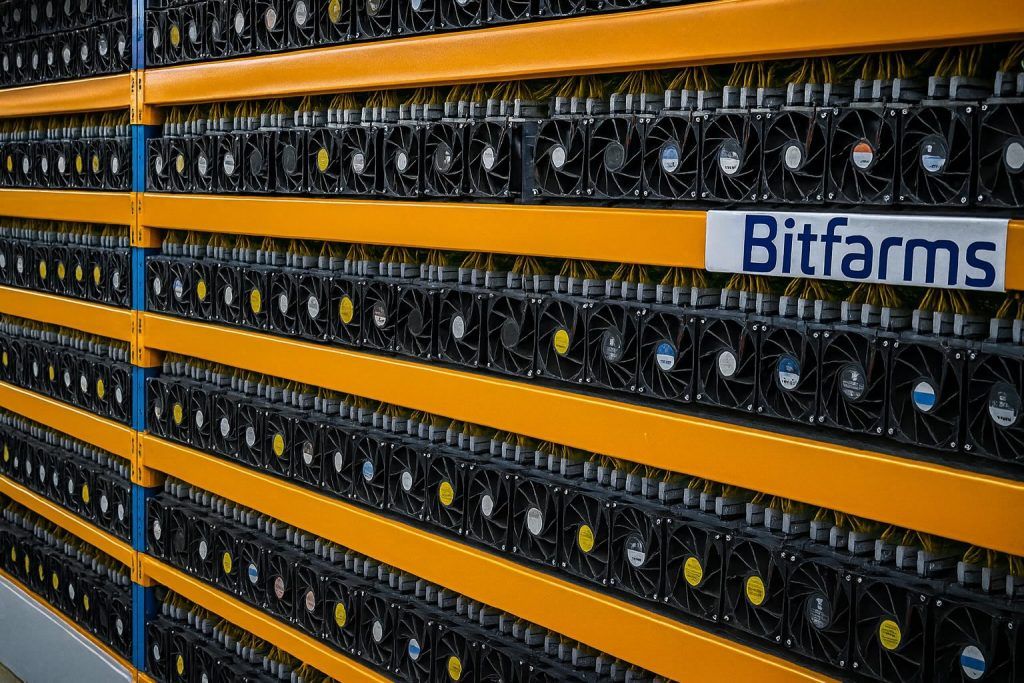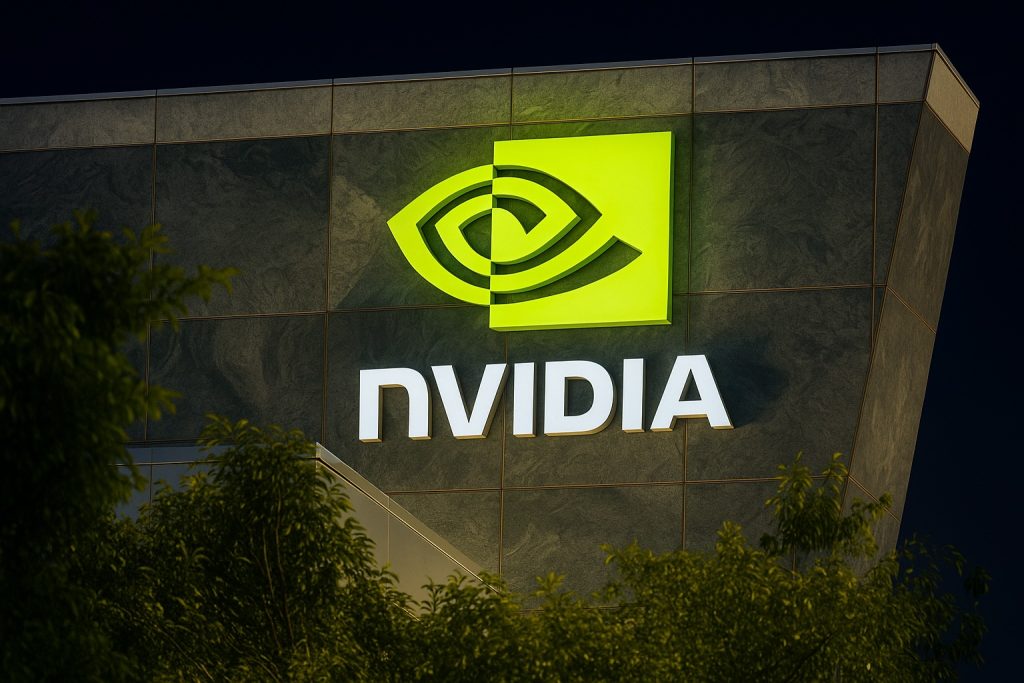- Stock performance: Broadcom’s share price is around $344 (Oct. 23 close) [1], roughly double its level a year ago [2]. In mid-Oct, AVGO peaked near $374 (post-split) [3] before a brief pullback amid market volatility.
- OpenAI deal: On Oct. 13, Broadcom and OpenAI announced a partnership to co-design 10 gigawatts of custom AI chips (worth about $10 billion over time) [4]. This news sent AVGO shares up ~10% on the day [5]. OpenAI’s CEO Sam Altman called the tie-up “a critical step in building the infrastructure needed to unlock AI’s potential” [6].
- Earnings & guidance: In Q3 2025, Broadcom reported $15.95B revenue (+22% YoY) and record free cash flow (~$7.0B) [7]. Management raised Q4 revenue guidance to ~$17.4B (ahead of analyst consensus) and expects Q4 AI-chip sales of $6.2B vs. $5.2B in Q3 [8]. CEO Hock Tan said customers are “strongly investing” in AI, fueling the beat-and-raise outlook [9].
- Analyst outlook: Wall Street is overwhelmingly bullish. About 90% of analysts rate AVGO a Buy [10]. Consensus 12-month targets cluster in the mid-$300s [11], with a few firms (KeyBanc, Barclays, etc.) pushing targets into the $400–460 range [12]. For example, Mizuho recently called Broadcom the “king of AI custom chips” and raised its target to $410 [13].
- Industry context: The semiconductor sector is booming – the Philadelphia Semiconductor Index just hit all-time highs [14] – as hyperscale firms race to build AI data centers. Broadcom (market cap ~$1.6T) is now one of tech’s biggest giants (only Nvidia is larger) [15]. Unlike pure-play chipmakers, Broadcom’s revenues are ~58% semiconductors and ~42% software (mostly VMware), giving it stable cash flow [16].
- Key risks: AVGO trades at a very high valuation (forward P/E ≈ 50×, far above peers [17]). Geopolitical and market jitters remain – e.g. a spike in U.S.-China trade tensions in early Oct caused the semis index to plunge ~6.3% and AVGO to dip ~5–6% in one day [18]. Other potential risks include concentrated customer mix (large clients could insource chips) and execution on lofty growth expectations.
OpenAI Partnership Fuels AI Chip Frenzy
Broadcom’s recent stock rally has been led by blockbuster AI deals. The centerpiece is an OpenAI collaboration announced on Oct. 13, 2025: Broadcom will co-develop OpenAI’s first in-house AI processor. Under this agreement, Broadcom will design and deploy racks of custom AI accelerator chips (10 GW total) for OpenAI starting in late 2026 [19]. The scale is enormous – 10 GW is roughly the power used by 8 million U.S. homes – and signals Broadcom’s deepening role in the AI infrastructure race. OpenAI CEO Sam Altman praised the partnership as “a critical step in building the infrastructure needed to unlock AI’s potential” [20], highlighting how important Broadcom is becoming to AI data centers.
The OpenAI news alone caused a near 10% one-day surge in Broadcom’s stock [21]. As TS2.tech notes, Broadcom has been “riding the twin waves of AI chip euphoria and strategic acquisitions,” which has driven its more than 70% rally so far in 2025 [22]. (Broadcom’s CEO Hock Tan has mentioned multiple unnamed cloud customers placing large ASIC orders [23] [24], consistent with this euphoria.) Industry observers emphasize that while Nvidia still dominates AI accelerators, Broadcom is carving out a niche by building bespoke chips for hyperscale cloud giants like Google, Meta and now OpenAI [25]. According to analyst Jacob Bourne (eMarketer), Broadcom’s “custom offerings for cloud giants are well-positioned as Big Tech races to push model training and inference forward” [26].
Record Earnings and Bullish Guidance
Broadcom’s recent earnings have backed up its hype. In Q3 FY2025 (ended Aug. 3), the company reported revenue of about $15.95 billion, up 22% year-over-year [27]. This blew past estimates and set a quarterly record. Non-GAAP net income was $8.4B (≈$4.14B GAAP), and crucially Broadcom turned this into a record $7.0+ billion of free cash flow (≈44% of revenue) [28]. Management highlighted “record third quarter revenue” driven by new AI accelerator orders, high-speed networking chips and VMware software sales [29].
On the guidance call, CEO Hock Tan reiterated that AI is accelerating the business. Broadcom raised its Q4 revenue forecast to about $17.4B [30] (well above the prior consensus of ~$17.1B). They expect AI-related chip sales to grow from $5.2B in Q3 to $6.2B in Q4 [31], a massive rate of growth. In short, Broadcom delivered a classic “beat-and-raise” quarter, with the premium valuation fully justified by the surge in AI spending. (For context, the firm has now logged 10+ consecutive quarters of double-digit growth, largely driven by AI demand [32].)
Stock Rally and Analyst Sentiment
Broadcom’s stock has more than doubled over the past 12 months, reflecting this story [33]. In September 2025, AVGO hit an all-time high near $374 [34] (post-split), up about 100% from ~$180 a year earlier. This rally has crowned Broadcom as one of the Magnificent Seven tech mega-caps, with a market value ~$1.6 trillion [35] (just behind Nvidia’s $2–3T). Analysts widely note that the stock’s rise is due to its central role in AI (“positioning itself at the center of the AI boom” [36]) and its deep backlog of orders. For example, Mizuho Securities recently dubbed Broadcom the “king of AI custom chips” and boosted its price target to $410 [37].
Consensus 12-month price targets are clustered in the mid-$300s [38] – roughly flat from current levels – but several bulls have much higher estimates. A TS2.tech report notes that KeyBanc and Barclays are modeling targets around $450–460, implying 30%+ upside [39]. These bullish views assume Broadcom keeps surprising to the upside on AI demand. Even so, the stock’s valuation is stretched: TS2 notes AVGO’s forward P/E is about 50×, far above industry averages [40]. Some analysts warn that much of this growth is already priced in. As one commentator on CNBC noted, Broadcom “delivered beats across the board and impressive guidance,” yet the stock only popped modestly because “the biggest culprit behind the lackluster upside response…was valuation” [41].
Industry and Competitor Landscape
Broadcom’s surge is part of a broader semiconductor and AI boom. The Philadelphia Semiconductor Index (which includes Nvidia, AMD, Broadcom, etc.) recently set new all-time highs [42], driven by strong earnings and bullish forecasts for AI chips. Nvidia (NVDA) remains the 800-pound gorilla in data-center AI (≈80–90% market share [43]), but Broadcom has sidestepped a direct GPU showdown by building custom ASICs and networking gear. In fact, Broadcom’s strategy is often called “coopetition” – it supplies AI infrastructure (switches, interconnects, TPUs) that complements Nvidia’s GPUs, so both companies can win as the AI pie grows [44].
Other chipmakers are also making moves. AMD (NVDA’s GPU rival) announced its own huge deal with OpenAI: a multi-year partnership to deploy 6 gigawatts of AMD GPUs, which sent AMD shares up ~34% on Oct. 6 [45]. (OpenAI even got warrants to buy an AMD stake as part of that deal [46].) Intel is pursuing AI chips via its Habana Labs Gaudi family (Gaudi 3 debuted in 2025), but so far its share remains small [47]. Qualcomm is targeting the edge-AI market with its Cloud AI100 accelerators [48]. In general, analysts view Broadcom’s recent wins as validating its approach: as Concurrent Asset Mgmt.’s Leah Bennett puts it, the AMD/OpenAI deal “helps validate [AMD’s] technology” – similarly, Broadcom’s OpenAI contract is seen as a vote of confidence in its chips [49] [50]. Meanwhile, market indexes have moved up with these themes: on Oct. 13 Broadcom and other AI/tech stocks rallied after President Trump signaled a softer trade stance with China, with Broadcom “surging almost 10%” on the OpenAI news [51].
Risks, Valuation and Outlook
Despite the excitement, investors are watching risks closely. Broadcom’s valuation is sky-high on any metric. At ~50× forward earnings [52] (or 85× on GAAP EPS [53]), the stock leaves little room for error. The company also has exposure to macro/geo uncertainties: for example, a sudden U.S.-China trade flare-up on Oct. 10 triggered a broad tech sell-off, sending the Semis index down 6.3% and Broadcom down about 5–6% in one day [54]. Similarly, regulatory or customer risks loom — Broadcom’s bets on custom chips mean its revenue rests on a few hyperscale clients. If one pulls back (or builds its own chips), that could hurt growth.
Another factor: Broadcom’s non-chip businesses. About 42% of revenue comes from its VMware software arm [55]. That adds stability now, but also regulatory scrutiny (some watchdogs have eyed the $69B VMware acquisition) and integration risk. Any slowdown in cloud spending or delays in new product launches could disappoint. On the technical side, analysts note the stock was extremely overbought in mid-October, so the recent pullback may simply be “healthy consolidation” [56] as investors take profits.
Bottom line: Broadcom’s outlook hinges on execution. Wall Street’s analysts generally assume Broadcom will capitalize on the AI boom – hence the high price targets – but caution is advised. As TS2.tech puts it, the company’s central role in AI has led to “outsized returns,” but “the optimism is baked in” [57]. In the near term, AVGO is clearly enjoying momentum from its OpenAI partnership and robust demand. The key question for investors is whether Broadcom can continue to beat expectations as growth scales. If it does, the stock could keep climbing toward those $400+ targets. If not, the premium valuation could lead to a sharp correction.
Sources: Recent financial news and filings including Reuters, TS2.tech analysis, and company disclosures as of Oct. 24, 2025 [58] [59] [60] [61]. These cover Broadcom’s AI deals, Q3 results, and analyst commentary. All data cited from the sources shown.
References
1. www.investing.com, 2. ts2.tech, 3. ts2.tech, 4. www.reuters.com, 5. www.reuters.com, 6. www.reuters.com, 7. ts2.tech, 8. ts2.tech, 9. ts2.tech, 10. ts2.tech, 11. ts2.tech, 12. ts2.tech, 13. ts2.tech, 14. www.reuters.com, 15. ts2.tech, 16. ts2.tech, 17. ts2.tech, 18. ts2.tech, 19. www.reuters.com, 20. www.reuters.com, 21. www.reuters.com, 22. ts2.tech, 23. www.reuters.com, 24. www.reuters.com, 25. ts2.tech, 26. www.reuters.com, 27. ts2.tech, 28. ts2.tech, 29. ts2.tech, 30. ts2.tech, 31. ts2.tech, 32. ts2.tech, 33. ts2.tech, 34. ts2.tech, 35. ts2.tech, 36. ts2.tech, 37. ts2.tech, 38. ts2.tech, 39. ts2.tech, 40. ts2.tech, 41. ts2.tech, 42. www.reuters.com, 43. ts2.tech, 44. ts2.tech, 45. www.reuters.com, 46. www.reuters.com, 47. ts2.tech, 48. ts2.tech, 49. www.reuters.com, 50. ts2.tech, 51. www.reuters.com, 52. ts2.tech, 53. ts2.tech, 54. ts2.tech, 55. ts2.tech, 56. ts2.tech, 57. ts2.tech, 58. www.reuters.com, 59. www.reuters.com, 60. ts2.tech, 61. ts2.tech
